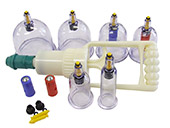Football Pitch-side First Aid
What does a Premier League Physio have in their Bag?
We’ve all seen the medical teams of our favourite sports teams dart onto the pitch to tend to a player who we hope isn’t injured and then dart back off the pitch again.
This is probably more so the case in football such as in Premier League, where FA rules require the game to be stopped and the referee has to signal to the medical team to let them know they can come onto the pitch.
You might’ve wondered what exactly is in their trusty sports first-aid kits and how it helps address the situation.

It might seem a bit dramatic but it gives the referee more control over the game and reduces time-wasting.
The referee has to observe certain rules on the seriousness of the injury, Law 5 for example, requires the referee to determine whether play needs to be stopped or if it's a serious injury and requires the medical team then the referee will make a decision about calling them on or not.
You may already know that Managers and Coaches can get yellow and red cards but similarly, Physios and Doctors can also receive cards if they are not off the pitch fast enough.
Before we address what a Physiotherapist needs on match day, it’s important to explain the medical teams of professional sports teams so you understand what each person’s role is.
It’s also interesting to know how the different people in the medical team safeguard the players of your favourite teams and it will make more sense when we go through the different products and tools used.
A medical team of a Premier League Club usually comprises both Doctors and other Sports Medicine Professionals. The Doctors are usually specialists in sports medicine and their purpose is to provide an expert medical opinion and to help with the diagnosis of certain conditions or injuries.
The rest of the team is made up of other Sports Medicine Professionals such as Physiotherapists, sports therapists, podiatrists, etc. although the doctors are also technically Sports Medicine Professionals.
There are of course also nutritionists and other people involved with caring for the health of the team but they’re not concerned with injury management.
In the video below, Daniel Simms from Watford FC takes us through the contents of his pitch-side first aid run-on bag. You can watch the video in full-screen mode or watch it from our videos page which has it in larger dimensions
You might note that at the beginning of the video Daniel says that the team doctors have a smaller bag, this hints at how a Physio’s job is more encompassing and requires more in terms of immediate treatment.
The doctor has a much smaller run-on bag because their main purpose is injury assessment as opposed to immediate treatment.
Depending on the injury, either the doctor or physiotherapist will be signalled to come on so sometimes they address the injury together but most of the time just the doctor will go on to assess the injury.
When the physio is needed, however, they often need loads of different things to treat the injury effectively.
We have a Buyer's Guide on common football injuries if you are looking for more information on the topic.
As mentioned in the video, the contents of a physio run-on bag range from PPE and general treatment such as medication to more specific treatment essentials like sports tape and pain-relief spray.
Some of the things mentioned in the video include:
- PPE
- Health Supplements
- Smelling Salts
- Sock Tape
- Freeze Spray
- Underwrap
- EAB Strapping
- Vicks and Deep Heat
- Betadine
- Vaseline
- Powerflex AFD
- Towels
- Various Tapes (Zinc Oxide, etc.)
- Dressings
Daniel also demonstrates how the contents of his bag are neatly and conveniently organised into separate and variably sized pockets; this makes It easier to find what he needs without digging around his bag while the referee gets increasing impatient.
For more traumatic injuries, the Doctors Medical Kit will typically have a lot of things that clubs at lower levels won’t have but the medical team will also have access to trauma care essentials like a stretcher or immobiliser.
Daniel mentions this towards the end of the video where he talks about the Doctors carrying some emergency essentials and he also mentions that things like airways are kept separately.
At the end of the day, each physiotherapist or sports therapist is unique and they have their own preferences for what they need on a matchday and what they include in their run-on bag.
They will more or less be the same contents covered in the video but it’s important to note that it’s subjective.
For more videos like this, please visit our Club Partnerships section of our Videos and for more information on Sports First Aid Kit Contents, please read our relevant Buyer's Guide


Did you find this article useful?
Why not share this with a colleague, patient or friend?